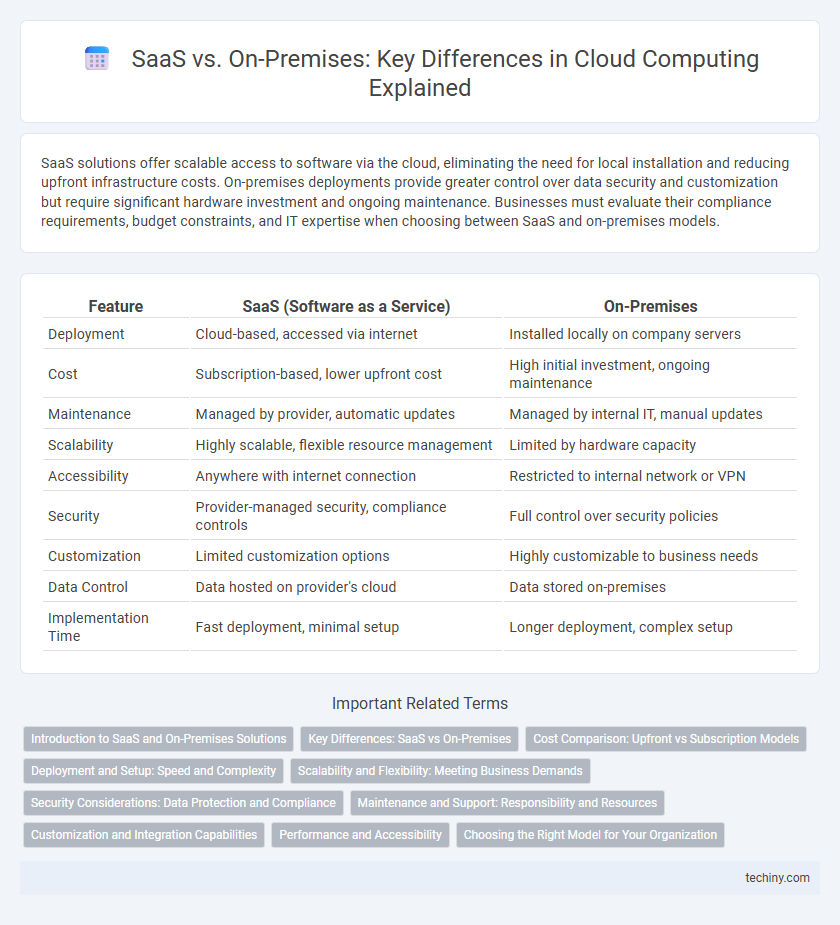SaaS solutions offer scalable access to software via the cloud, eliminating the need for local installation and reducing upfront infrastructure costs. On-premises deployments provide greater control over data security and customization but require significant hardware investment and ongoing maintenance. Businesses must evaluate their compliance requirements, budget constraints, and IT expertise when choosing between SaaS and on-premises models.
Table of Comparison
| Feature | SaaS (Software as a Service) | On-Premises |
|---|---|---|
| Deployment | Cloud-based, accessed via internet | Installed locally on company servers |
| Cost | Subscription-based, lower upfront cost | High initial investment, ongoing maintenance |
| Maintenance | Managed by provider, automatic updates | Managed by internal IT, manual updates |
| Scalability | Highly scalable, flexible resource management | Limited by hardware capacity |
| Accessibility | Anywhere with internet connection | Restricted to internal network or VPN |
| Security | Provider-managed security, compliance controls | Full control over security policies |
| Customization | Limited customization options | Highly customizable to business needs |
| Data Control | Data hosted on provider's cloud | Data stored on-premises |
| Implementation Time | Fast deployment, minimal setup | Longer deployment, complex setup |
Introduction to SaaS and On-Premises Solutions
SaaS (Software as a Service) delivers applications over the internet, eliminating the need for local installation and maintenance, thus providing scalability and automatic updates. On-premises solutions require software to be installed and operated on local servers, offering greater control and customization but demanding higher upfront costs and ongoing management. Businesses evaluate SaaS versus on-premises based on factors like security preferences, cost structures, and IT resource availability.
Key Differences: SaaS vs On-Premises
SaaS offers cloud-hosted applications accessible via the internet, eliminating the need for local infrastructure and reducing upfront costs, while On-Premises requires installing software on local servers with higher control and customization options but increased maintenance and hardware expenses. SaaS solutions provide automatic updates and scalability, contrasting with On-Premises systems that demand manual upgrades and fixed capacity planning. Security models differ as SaaS relies on provider-managed security protocols, whereas On-Premises depends on in-house IT teams to safeguard data and comply with regulations.
Cost Comparison: Upfront vs Subscription Models
SaaS solutions typically require lower upfront costs due to subscription-based pricing, eliminating the need for significant hardware investments and ongoing maintenance expenses associated with on-premises infrastructure. On-premises deployments demand substantial initial capital expenditure for servers, software licenses, and IT personnel, with ongoing costs for upgrades and support. Subscription models in SaaS offer predictable operational expenses and scalability, whereas on-premises costs can be variable and increase with infrastructure aging and capacity expansion.
Deployment and Setup: Speed and Complexity
SaaS deployment offers rapid setup with minimal IT involvement, enabling businesses to access software instantly via the cloud, reducing time-to-value significantly. On-premises installation requires extensive hardware configuration, software installation, and ongoing maintenance, often causing longer deployment cycles and higher complexity. The streamlined SaaS setup accelerates updates and scalability, while on-premises demands comprehensive planning and resource allocation for infrastructure readiness.
Scalability and Flexibility: Meeting Business Demands
SaaS solutions offer unparalleled scalability by allowing businesses to quickly adjust resources and user capacity without significant upfront investments, matching fluctuating demands effortlessly. On-premises systems require substantial infrastructure upgrades and manual adjustments to scale, often leading to higher costs and longer deployment times. Flexibility in SaaS enables seamless updates and integration with other cloud services, whereas on-premises setups may face limitations due to hardware constraints and complex management.
Security Considerations: Data Protection and Compliance
SaaS solutions leverage robust encryption protocols and continuous security updates managed by providers to ensure data protection, while on-premises systems require in-house expertise to implement and maintain security measures. Compliance with regulations such as GDPR, HIPAA, and PCI-DSS is streamlined in SaaS due to provider certifications and audit capabilities, whereas on-premises deployments demand rigorous internal audits and customized compliance controls. Data residency and control are key factors; SaaS relies on cloud infrastructure policies, whereas on-premises offers direct physical data access but increases the risk of insider threats.
Maintenance and Support: Responsibility and Resources
SaaS providers handle all maintenance and support tasks, reducing the need for internal IT resources and enabling automatic updates and security patches. On-premises solutions require dedicated IT teams to manage hardware, software updates, and troubleshooting, increasing operational costs and complexity. Companies must evaluate their capacity for ongoing support and resource allocation when choosing between SaaS and on-premises deployments.
Customization and Integration Capabilities
SaaS solutions offer limited customization due to standardized cloud-based architectures, often restricting deep integration with legacy systems. On-premises software allows extensive customization, enabling organizations to tailor functionalities and seamlessly integrate with complex internal IT infrastructures. This flexibility supports unique business workflows but requires significant internal resources for development and maintenance.
Performance and Accessibility
SaaS platforms offer high accessibility with cloud-based delivery, enabling users to access applications from any device with internet connectivity, while performance can be influenced by network speed and cloud provider infrastructure. On-premises solutions provide consistent performance through dedicated local hardware and direct access but limit accessibility to specific physical locations or secured networks. Choosing SaaS enhances scalability and remote collaboration, whereas on-premises ensures more control over latency and data processing speeds.
Choosing the Right Model for Your Organization
Selecting the appropriate deployment model between SaaS and On-Premises depends on factors such as budget constraints, scalability needs, and IT infrastructure. SaaS offers rapid deployment, automatic updates, and reduced maintenance costs, making it ideal for organizations seeking agility and minimal upfront investment. On-Premises solutions provide greater control, customization, and compliance options, benefiting enterprises with stringent data security requirements and existing IT resources.
SaaS vs On-Premises Infographic

 techiny.com
techiny.com